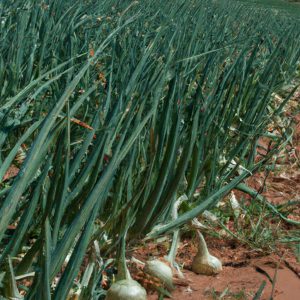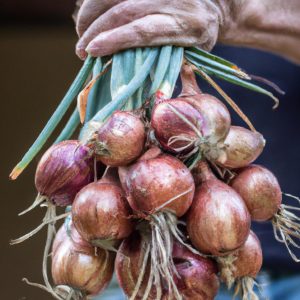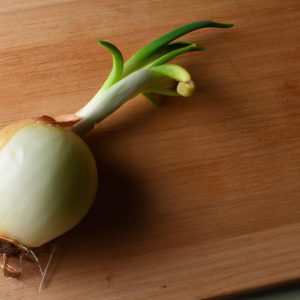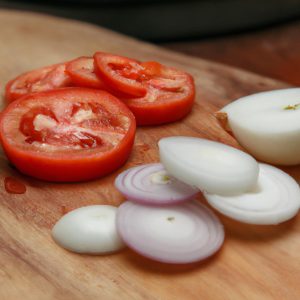Have you ever been halfway through a recipe only to realize you’re short on onions? Or maybe you simply prefer the convenience of using pre-minced onion in your cooking. Whatever the reason, understanding how much minced onion equals one onion is a fundamental skill for any home cook.
In this article, I’ll provide you with a comprehensive guide on how to convert between minced onion and whole onion measurements. We’ll cover factors that affect the conversion ratio, advantages of using minced onion, and tips for adjusting the amount of minced onion in recipes based on personal preference. Additionally, I’ll share with you a simple method for making minced onion at home.
By the end of this article, you’ll have a better understanding of how much minced onion you need to use in your recipes and the benefits of doing so. So, let’s dive in!
What is Minced Onion?

Definition of Minced Onion
Minced onion is a popular ingredient used in many recipes, including soups, stews, stir-fries, and marinades. Minced onion is finely chopped and has a more delicate texture than diced onions. It blends well with other ingredients and provides a consistent flavor throughout the dish.
How It is Made and Its Uses in Cooking
Minced onion can be made by hand or with a food processor. It is often sold pre-minced in grocery stores and can be found fresh, frozen, or dried. One of the benefits of using minced onion is that it can save time and effort in the kitchen. No more tears from chopping whole onions, and no more uneven sizes that can lead to inconsistent cooking.
In addition to its convenience, minced onion also provides a unique flavor profile in cooking. It has a milder, sweeter taste than diced onions, making it a great addition to recipes where a more subtle onion flavor is desired. Minced onion is also a great thickener for sauces and soups, as it releases more of its natural juices than a whole onion would.
How much minced onion equals one onion?

Cooking with onions is a staple in most kitchens. However, recipes often call for onions in different forms, such as diced, chopped, or minced. If you find yourself unsure about how much minced onion to use in place of a whole onion, here’s what you need to know.
Factors that affect the conversion ratio
The conversion ratio of minced onion to whole onion can vary depending on several factors. Size, variety, and freshness can all have an impact on the amount of minced onion needed to substitute for a whole onion. For example, a large onion may yield more minced onion than a small one, while a sweeter onion may require less minced onion compared to a more pungent variety.
General guidelines for conversion
As a general rule of thumb, one tablespoon of minced onion is equivalent to one medium onion. However, this is not an exact science and can vary depending on the factors mentioned above. While it’s always best to measure ingredients accurately, using this guideline can be a helpful starting point.
Tips for adjusting the amount of minced onion in recipes
Personal taste preferences can also affect how much minced onion you should use in your recipes. If you prefer a milder onion flavor, you may want to use less minced onion than what is called for in the recipe. On the other hand, if you love the taste of onions, you may want to add a little extra to your dish.
In general, it’s always best to start with the recommended amount of minced onion and adjust as needed based on your personal preference. With a little experimentation, you’ll be able to find the perfect balance of onion flavor in your dishes.
Advantages of Using Minced Onion

Cooking with minced onion has several advantages over using whole onions. Here are some of the benefits you can expect when using minced onion in your recipes:
Convenience and Time-Saving Benefits
One of the primary advantages of using minced onion is the convenience it offers. You don’t have to worry about peeling and chopping whole onions, which can be time-consuming and messy. With minced onion, you can simply measure out the amount you need and add it to your recipe. This is especially helpful if you’re short on time or don’t have the energy to chop onions after a long day.
Potential Cost Savings
Using minced onion can also be a cost-effective option, especially if you’re buying it in bulk. While the price of minced onion may be slightly higher per ounce than whole onions, you may end up saving money in the long run by reducing food waste. With whole onions, you may not always use the entire onion, leading to unused portions that go bad. With minced onion, you can measure out the exact amount you need, reducing the likelihood of waste.
Better Texture and Appearance in Dishes
Minced onion can also provide better texture and appearance in dishes than whole onions. Because minced onion is finely chopped, it distributes more evenly throughout a dish, providing a more consistent flavor and texture. Additionally, it can be used to thicken sauces and blends more easily into dishes, making it an ideal ingredient for soups, stews, and casseroles.
Overall, using minced onion can offer several advantages to home cooks. It’s convenient, cost-effective, and can provide better texture and appearance in dishes. In the next section, I’ll share tips on how to make minced onion at home.
How to Make Minced Onion at Home
Are you tired of buying pre-minced onion, or maybe you can’t find it in your local grocery store? Don’t worry; making minced onion at home is simple and cost-effective. Plus, you have more control over the texture and freshness of your minced onion.
Equipment and Ingredients Needed
To make minced onion at home, you’ll need the following equipment and ingredients:
- Sharp knife
- Cutting board
- Onion(s)
- Food processor or blender
- Airtight container for storing minced onion
Step-by-Step Instructions for Making and Storing Minced Onion
- Peel the skin off the onion and cut off the top and bottom ends.
- Cut the onion in half from top to bottom, then make horizontal cuts across each half.
- Holding the onion together, make vertical cuts from top to bottom.
- Place the onion pieces into a food processor or blender and pulse until the desired texture is reached. Be careful not to over-process, or you’ll end up with onion paste.
- Transfer the minced onion into an airtight container and store in the refrigerator for up to two weeks or freeze for up to three months.
That’s it! Making minced onion at home is that simple. Not only is it cost-effective, but it’s also a great way to ensure that you have fresh minced onion on hand whenever you need it. Give it a try and see how it can elevate your cooking game.
Conclusion
In conclusion, understanding how much minced onion equals one onion is a crucial skill for any home cook. By following the guidelines outlined in this article, you can easily convert between the two measurements and adjust recipes to your personal preference.
Using minced onion offers several advantages, including convenience, cost savings, and improved texture and appearance in dishes. Additionally, making minced onion at home is a simple and cost-effective way to ensure you always have it on hand.
Remember, when it comes to cooking, experimentation is key. Don’t be afraid to adjust the amount of minced onion in a recipe to suit your taste. And if you’re ever in doubt, feel free to refer back to this guide.
At onionfacts.com, we strive to provide informative and engaging content to help you become a better home cook. We hope you found this article helpful and encourage you to share it with your fellow cooking enthusiasts. Happy cooking!







